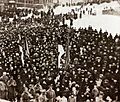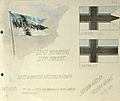Flag of Estonia facts for kids
The flag of Estonia is a very important national symbol. It has three equal stripes that go across it. From top to bottom, the colors are blue, black, and white. These colors are not just pretty; they each have a special meaning for the Estonian people.
The blue stripe represents the beautiful sky above Estonia. It also stands for the country's lakes and the sea. The black stripe reminds people of the rich soil of Estonia. It also represents the traditional black coats worn by farmers. The white stripe symbolizes happiness, hope, and the bright future of the nation. It also stands for the pure snow that covers Estonia in winter. In the Estonian language, the flag is called "sinimustvalge." This simply means "blue-black-white."
Contents
The Flag's History and Meaning
The design of the Estonian flag was created in the 1880s. It was first used by Estonian university students. They wanted a symbol for their national awakening. This was a time when Estonians were starting to feel proud of their own culture. They dreamed of having their own independent country.
Becoming a National Symbol
The blue, black, and white flag quickly became popular. It was seen as a symbol of the Estonian people's hopes. When Estonia finally became an independent country in 1918, this flag was officially adopted. It was a proud moment for the new nation. The flag flew high, showing the world that Estonia was free.
Challenges and Return
However, Estonia's independence did not last forever. During World War II, the country was occupied by other powers. For many years, the Estonian flag could not be flown freely. It became a hidden symbol of hope and resistance. People kept small flags in secret. They dreamed of the day their flag would fly again.
In 1990, Estonia regained its independence. The blue, black, and white flag was proudly raised once more. This was a very emotional moment for many Estonians. It showed that their long struggle for freedom had finally succeeded. Today, the flag is a strong reminder of Estonia's journey. It represents the country's history, its people, and its bright future.
Images for kids
-
Flags of Estonia on display during the announcement of the declaration of Independence in Pärnu on 23 February 1918. One of the first images of the Republic of Estonia.
-
Flag of Denmark (1370). According to legend this flag originated in a 1219 battle in Estonia but the first historical record is at least 25 years later than the end of Danish Estonia.
See also
 In Spanish: Bandera de Estonia para niños
In Spanish: Bandera de Estonia para niños








